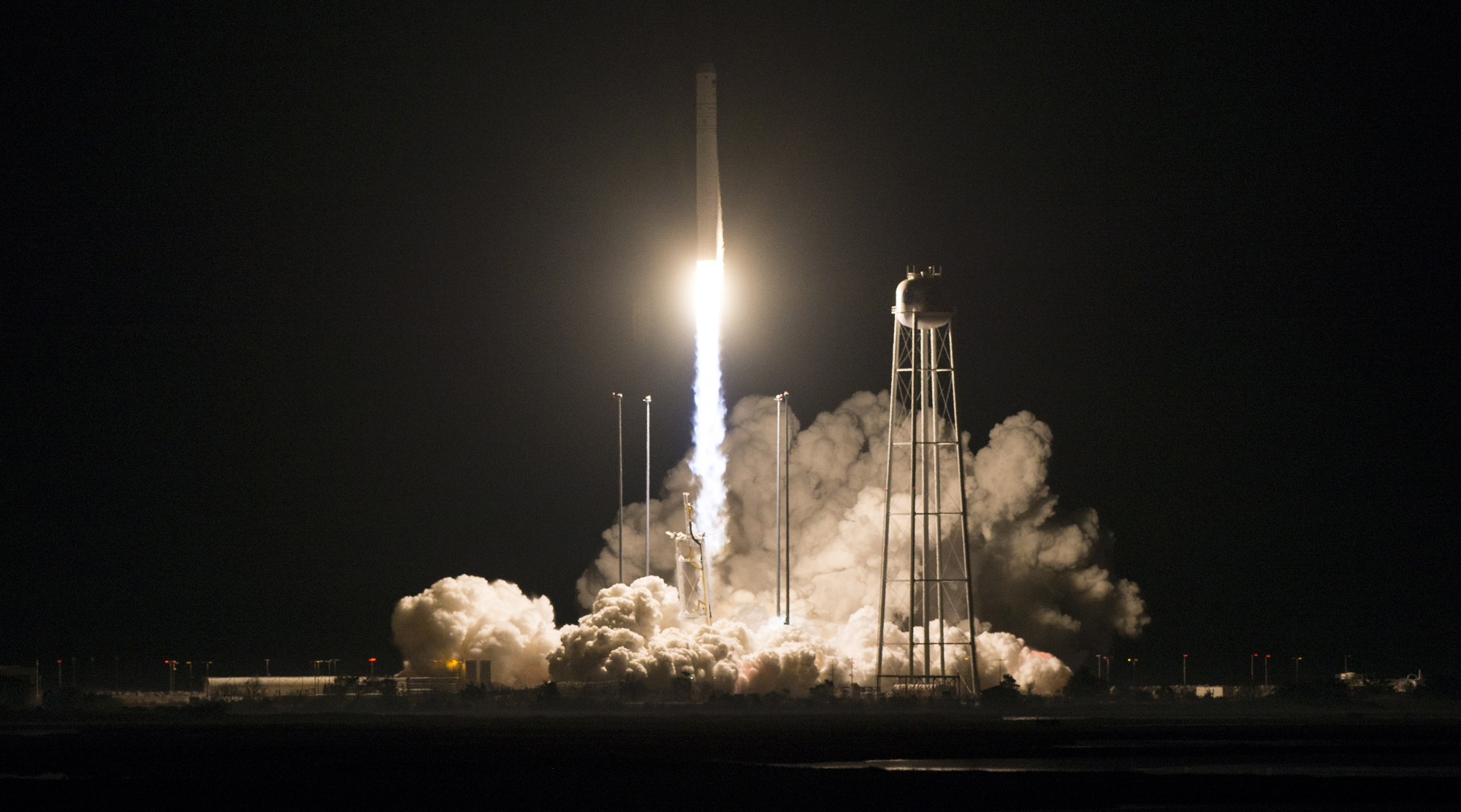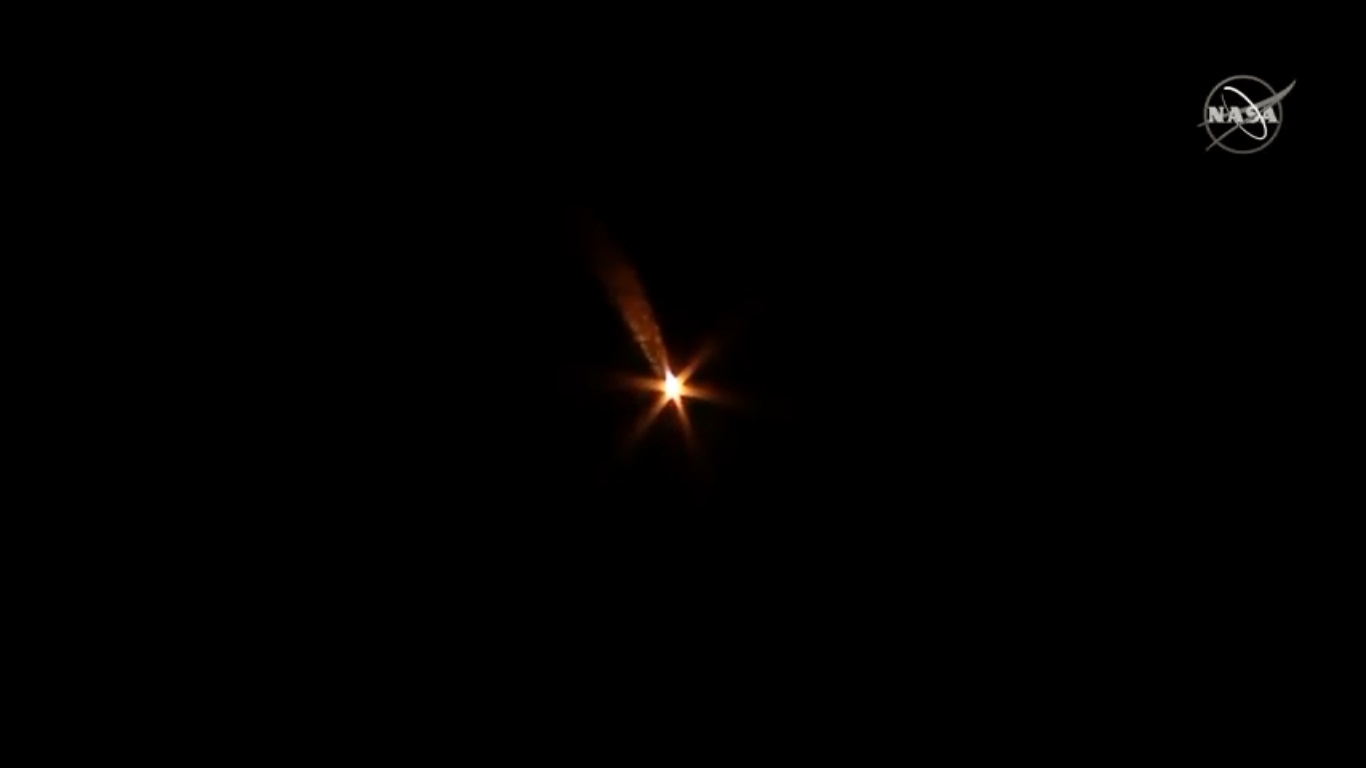Antares Rocket Launches NASA Cargo to Space Station in Dazzling Predawn Liftoff
WALLOPS ISLAND, Virginia — A Northrop Grumman Antares rocket lit up the predawn sky over Virginia Saturday (Nov. 17) to launch a privately built Cygnus spaceship filled with NASA supplies (and even some ice cream) to the International Space Station.
The Antares rocket soared into the clear, chilly skies over Virginia's Eastern Shore carrying an uncrewed Cygnus spacecraft filled with tons of science experiments, food and other vital supplies for the space station's crew. Liftoff occurred at 4:01 a.m. EST (0901 GMT) from Pad-0A of the Mid-Atlantic Regional Spaceport here at NASA's Wallops Flight Facility after two days of delay due to bad weather.
"What an outstanding launch," said Joel Montalbano, NASA's deputy station program manager, after the dazzling liftoff. Cygnus is now on track for an arrival at the station on Monday (Nov. 19), he added.
There's about 7,400 lbs. (3,400 kilograms) for the station's three-person Expedition 57 crew packed aboard the Cygnus spacecraft. That includes fresh fruit and ice cream, a welcome treat for the astronauts, Montalbano said before launch. [See more amazing photos of the Antares launch]

If all goes well, the cargo ship will arrive Monday at 5:20 a.m. EST (1020 GMT) and be captured via robotic arm by station astronauts. The mission, called NG-10, is the tenth Cygnus flight for NASA under a commercial contract with Northrop Grumman.
Northrop Grumman named the Cygnus the S.S. John Young in honor of the famed NASA astronaut John Young, who flew on the Gemini 3 and 10 missions, Apollo 10 and 16, and the STS-1 and STS-9 space shuttle flights. Young died in January at age 87.
Weird science on Cygnus
There's some seriously weird science launching into space on Cygnus.
Get the Space.com Newsletter
Breaking space news, the latest updates on rocket launches, skywatching events and more!
Tara Ruttley, NASA's associate chief scientist for microgravity research, said there's enough science gear for more than 250 different experiments designed by scientists and students on Earth.
That includes a protein-growth study by the Michael J. Fox Foundation to investigate the structure of the LRRK2 protein, which has been implicated in the progression of Parkinson's disease.
"Knowing the elusive structure of this particular protein could help improve therapeutic treatment of that disease," Ruttley said.
Another experiment is sending the first-ever "lab-on-chip" experiment to the space station to study how muscle cells atrophy in weightlessness. Still another team from Penn State University will use a small centrifuge on the space station to test how to make concrete in space for future bases on the moon or Mars.
And then there's the Refabricator. This combo 3D printer and recycler is designed not only to print items, but also recycle waste plastic back into feed stock for the printer like a sort of proto-replicator from "Star Trek."
"It's a key part of NASA's in-space manufacturing tech demo roadmap," Ruttley said.

Cygnus will stay parked at the space station until February, when it will be filled with trash and released to intentionally burn up in Earth's atmosphere. But before Cygnus destroys itself, it will deploy a series of small, student-built cubesats and 105 tiny "chipsats" — tiny wafer-like satellites that measure just 1.4 inches (3.5 centimeters) per side.
"They're like tiny little circuit boards that can integrate potentially a lot of different sensors," Ruttley said, adding that the chipsat test aims to see how they survive. "They're, like, really tiny."
Double delivery for space station
Today's launch of Antares and Cygnus comes just one day after another robotic cargo ship, Russia's Progress 71 vehicle, launched on its own mission to the space station. That mission launched nearly 3 tons of food, fuel and other supplies.
Progress 71 will arrive at the space station on Sunday (Nov. 18) with Cygnus to follow close behind Monday morning.
One thing not on board Cygnus or the Progress 71: a Thanksgiving dinner for the station's crew.
Astronauts traditionally observe the American Thanksgiving holiday as one of many celebrations to mark the diverse cultures of station crews. The Expedition 57 crew, for example, includes American Serena Auńon-Chancellor, Russian cosmonaut Sergey Prokopyev and German commander Alexander Gerst of the European Space Agency.
So why no turkey dinner on Cygnus or Progress? There's a simple answer: The dinner's already there. It was shipped up on an early resupply mission for the Expedition 57 crew, Montalbano said before Saturday's launch.
"We like to plan ahead," he added.
Editor's note: This story was updated at 7 a.m. EST to include NASA statements from a post-launch press conference. You can watch the arrivals of Progress 71 and Cygnus live here, courtesy of NASA TV. NASA's Progress 71 webcast will begin Sunday at 1:45 p.m. EST (1845 GMT). The Cygnus NG-10 arrival webcast will begin at 4 a.m. EST (0900 GMT).
Email Tariq Malik at tmalik@space.com or follow him @tariqjmalik. Follow us @Spacedotcom and Facebook. Original article on Space.com.
Join our Space Forums to keep talking space on the latest missions, night sky and more! And if you have a news tip, correction or comment, let us know at: community@space.com.

Tariq is the Editor-in-Chief of Space.com and joined the team in 2001, first as an intern and staff writer, and later as an editor. He covers human spaceflight, exploration and space science, as well as skywatching and entertainment. He became Space.com's Managing Editor in 2009 and Editor-in-Chief in 2019. Before joining Space.com, Tariq was a staff reporter for The Los Angeles Times covering education and city beats in La Habra, Fullerton and Huntington Beach. In October 2022, Tariq received the Harry Kolcum Award for excellence in space reporting from the National Space Club Florida Committee. He is also an Eagle Scout (yes, he has the Space Exploration merit badge) and went to Space Camp four times as a kid and a fifth time as an adult. He has journalism degrees from the University of Southern California and New York University. You can find Tariq at Space.com and as the co-host to the This Week In Space podcast with space historian Rod Pyle on the TWiT network. To see his latest project, you can follow Tariq on Twitter @tariqjmalik.









